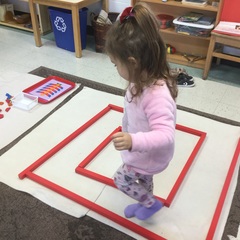Movements Impact on Learning and Cognition
All of the works in the Primary classroom allow for some type of movement using both gross and fine motor skills. Movement lets the children use all of their senses so that they are able to learn and take in the world around them.
In the Primary classroom, freedom of movement is an essential part of our environment. The classroom is prepared so that the children are able to move and make their own choices in selecting works they would like to do.
In the Primary 3 classroom the children are doing celery cutting in the Practical life area. This is extended into a lesson in grace and courtesy as they serve the slices to their peers that are working.
In the Sensorial area the Pink Tower and the Brown Stair cubes exercise both fine and gross motor skills. The child has to remove each cube or rod from the shelf one at a time, carefully carry it to a rug and place it randomly on the rug.  Once all the rods/cubes are on the rug the child can build the stair or tower. Then the tower/stair is carefully disassembled and the rods/cubes are returned one by one to the shelf. Children can also match the cubes to picture cards that are laid out randomly on the rug. These activities require a great deal of effort for younger children.
Once all the rods/cubes are on the rug the child can build the stair or tower. Then the tower/stair is carefully disassembled and the rods/cubes are returned one by one to the shelf. Children can also match the cubes to picture cards that are laid out randomly on the rug. These activities require a great deal of effort for younger children. 
One of my favorite activities is the “Go get enough” exercise. . When doing this work the child lays out one numeral card and has to walk to the opposite side of the classroom to get the amount of items for the number on the card. This activity helps develop the child’s memory and requires focus and staying on task. This is just one of the many extension’s in the classroom.
Movement extends into our outside environment. The children love doing cloth washing, cleaning the door and windows, painting the porch and coloring at the easel. These are just a few of our outside activities.
 I have noticed in the classroom that when the children are able to move around freely when they are working, they are happier and peaceful.
I have noticed in the classroom that when the children are able to move around freely when they are working, they are happier and peaceful.

